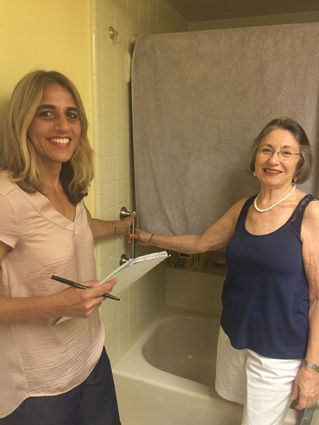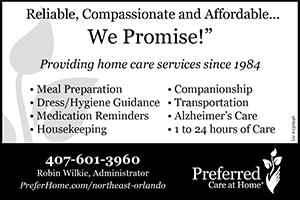Getting a head start on 'Aging in Place'
Years later, I can recall the moment when my friend's son got his head stuck between the wooden rails on our staircase landing. While we laugh about the predicament today, at the time it wasn't so funny for the little red-faced toddler who stuck his neck out in the wrong place. (We wiggled him out unharmed, except for the mommies, who became major head-cases during the extrication.) Let's just say that when we first moved into our house 16 years ago, we had quite a bit child-proofing to do. Outlets were plugged, railings were wrapped, and rounded edges were placed over rough corners.
Today, with my mother-in-law, Stefanie, living around the corner, my thoughts are less on child-safety and more on 'senior-proofing' or making modifications that promote "aging in place" safely. After moving to town about six months ago, Stefanie spent several months remodeling her townhome to make it more to her specifications, including adding some senior-friendly changes like grab bars to her bathroom walls. Although Stefanie is still youthful and spry at the age of 76, we decided to have an aging-in-place specialist pay her a home visit, with hopes of discovering what kind of modifications might need to be made so that she could age in place, and grow old in the home that she had spent so much making her own.
If you are not familiar with the concept of "aging in place," it is a movement defined by Emily Newman, senior resource specialist of the Orlando's Senior Help Desk, as "the ability to age safely and independently in one's own home and community of choice." Emily also suggests, and many older adults concur (including my mother-in-law, and rather loudly) that they would prefer to age in place, or remain in their homes as long as they are able.
With aging in place safely as our goal, I reached out to my friend and neighbor, Rebecca Seidler, who recently started a company bearing the same name. Prior to opening Aging in Place Safely, Rebecca received training as a Certified Aging in Place Specialist (CAPS), and is also licensed as an occupational therapy assistant, and has helped seniors live safely in their homes for many years. Rebecca shared that her passion is to "keep seniors at home as long as possible, in a safe and accessible environment."
After chatting on the phone for a few minutes one evening, my hardworking neighbor agreed to hop in the car with me after hours and take the short ride to assess the long-term safety of my mother-in-law's new home. On the drive over, Rebecca shared that tripping and falling is the number one danger for those choosing to age in place. She sees her job as removing as many barriers as possible to prevent these accidents. Rebecca is a big fan of getting a 'head start' on aging in place, and making modifications to prevent an injury, rather than to accommodate one. Many of these modifications make the home safer for residents of every age.
The home assessment began as soon as we rang the doorbell, and my mother-in-law welcomed the two of us into her home. Rebecca's evaluation started right at the front door (not to mention the mailbox), and she took a moment to measure the threshold, which was raised up about 6 inches. Rebecca wasn't thrilled about the rise in the doorway, and suggested that Stefanie think about adding a small ramp to the entry at some point in the future. Apparently, thresholds are a big source of tripping, especially when groceries, packages, and other distractions are thrown into the mix.
The area rugs which Stefanie has scattered liberally throughout her living room also carpeted the small home with hazards. Though my mother-in-law had added no-slip liners under each rug, Rebecca demonstrated that the corners were easily lifted up with a tiny kick of the shoe. A simple and inexpensive solution of adding double stick tape to the corners was recommended.
The CAPS specialist praised the home for its wide doorways (for the most part), that would allow easy access for a wheelchair or a walker. Rebecca noted that life can change in an instant, and it's always better to be prepared for home flexibility, when possible. No one knows this better than my mother-in-law, as several years she broke her hip from a fall while gardening, and was relegated to a rehab facility and the use of a walker for several uncomfortable months.
According to Rebecca, Stefanie's sunken master shower was a safety nightmare, as a large threshold needed to be crossed, followed by a step down. Fortunately, my mother-in-law was using that particular shower as extra closet space, and was choosing to shower in the guest bath, which fared much better on the safety scale. Rebecca recommended simple changes like a shower seat and a hand-held shower head to decrease the risk of a fall even more. Though she appreciated the grab bar inside the shower, the CAPS specialist would have liked to see one near the toilet as well. While the entire assessment was rather thorough, I have done my best to hit the highlights, to demonstrate what a senior can expect during a home evaluation.
Thanks to Rebecca, we learned that aging in place safely is a process that requires regular reassessment, and depends upon the circumstances and health needs of the individual senior. While my mother-in-law might not need some of these modifications immediately, they were good to keep in the mind for a later date, so that she could continue to age in place in a safe way throughout the years.
While I'm very lucky to have a trusted neighbor in the industry, there are many agencies that can be helpful with this movement, and can be found with through simple "google" search. Additionally, AARP has a thorough online toolkit to help assess if aging in place is right for you or someone you love. Rebecca also has an aging–in-place assessment on her website (www.aginginplacesafelyconsulting.com), and recommends whoever you contact for guidance on this subject have a CAPS certification or a background in occupational therapy.
Meanwhile, we have engaged in some mid-life modifications, as well. We have taped our rugs down, and are doing our best to keep the threshold clear and package free, despite our obsession with Amazon Prime. With a little planning, we are prepared to keep one step ahead, so we can live safely and stick it out a little while longer in the home where we have experienced so many endearing (and colorful) memories.
Please come back for another tidbit... coming soon!
Tidbits from the Sandwich Generation is a series of blogs by Pamela Ruben about managing the multi-generations. If you are sandwiched in between raising a family of children or young adults, and caring for aging parents, take a bite out of life with this new blog! Just a 'tidbit' is recommended for anyone who spends time with older adults, or is preparing for life's next stages. Laugh, cry, and relate as our blogger is pulled from all sides by family members young and old. Check out additional posts at http://www.jewishpavilion.org/blog.
For no cost help for issues pertaining to older adults contact the Orlando Senior Help Desk, a 501(c)3 nonprofit, at 407-678-9363 or visit http://www.orlandoseniorhelpdesk.org. Certified Aging in Place Specialist, Rebecca Seidler, can be reached at http://www.aginginplacesafelyconsulting.com or at 407-595-3342.










Reader Comments(0)